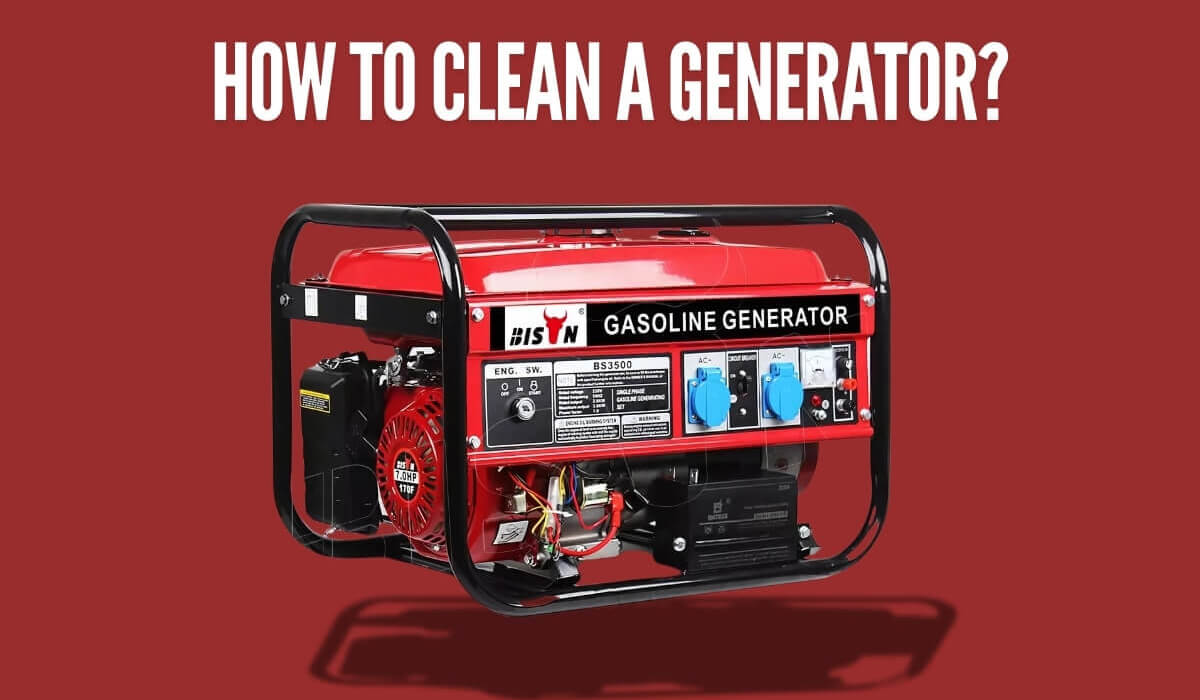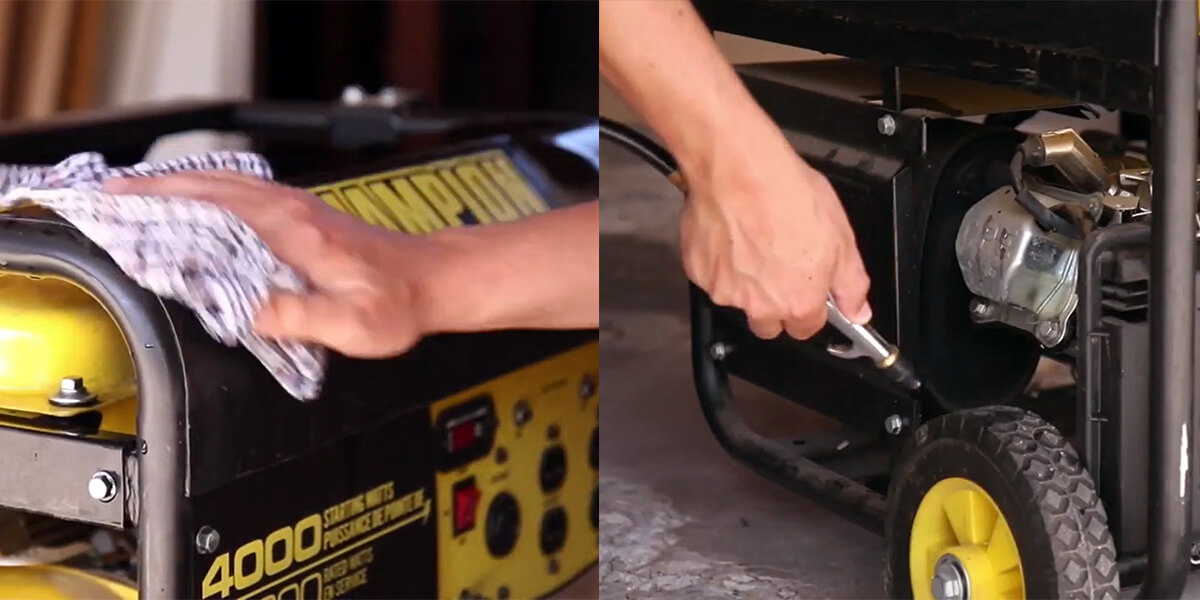How to clean a generator
- BY BISON
Table of Contents
Over time, dust, debris, and moisture can accumulate on and inside your generator. This buildup can lead to various problems, such as overheating, reduced efficiency, and even unexpected breakdowns. At this point, regular cleaning is essential to keep your generator operating efficiently and lasting longer.
Proper maintenance includes both external cleaning and internal care. So how should you start cleaning your generator? In this blog, we’ll explore the importance of regular generator maintenance, how dirt affects performance, and walk through basic cleaning steps.

Safety precautions and cleaning preparation
1. Required tools and materials
- Cleaning supplies: soft microfiber cloths, soft-bristle brushes, a vacuum cleaner with brush attachment, compressed air canister.
- Cleaning solutions: mild dish soap mixed with water, non-corrosive engine degreaser, or non-flammable, quick-drying electrical contact cleaner.
- Safety equipment: protective gloves, safety goggles, and a dust mask.
- Basic tools: screwdrivers, wrenches, and a flashlight.
2. Turn off and cool down
Safely unplug or disconnect the generator from any connected systems. Always turn off the generator and allow it to cool for at least 30 minutes before starting any cleaning. Then remove the spark plugs and drain the tank.
3. Work in a well-ventilated area
Cleaning should be done outdoors or in a well-ventilated space. Fumes from fuel residue or cleaning agents can be harmful if inhaled in confined areas.
How to clean a generator: a simple 4-part guide
1. External cleaning
- Remove surface debris: Use a soft brush or shop vacuum to remove leaves, dirt, and dust from the generator’s surface, especially around the wheels, handles, air intake, and exhaust.
- Wipe it down: Use a damp cloth with mild soap and water to clean surfaces. Avoid soaking the machine—just wipe gently.
- Clean cooling fins and vents: Use a dry brush or compressed air to clear out cooling fins and air vents. These areas must stay open for airflow and to prevent overheating.

2. Internal cleaning
- Refer to the manual: Review your generator’s manual for internal cleaning guidance. Only open parts that are approved for user maintenance.
- Use compressed air: Gently blow out dust from open internal areas like around the engine or behind accessible panels. Never insert tools into the engine.
- Avoid complex disassembly: Do not open or attempt to clean sensitive parts like the engine, carburetor, or fuel system—these should be handled by professionals.
3. Engine maintenance
- Check and change the oil: Use the dipstick to check oil levels. If dirty or low, drain the old oil and refill with the correct oil type listed in your manual.
- Clean or replace the air filter: Remove the air filter. Clean foam filters with soapy water, let them dry and apply a light coating of oil. Replace dirty or damaged paper filters.
- Clean the cooling system: Use a soft brush or compressed air to clean fans and radiators. Avoid high-pressure water, which can damage fins.
- Inspect the spark plug: Remove the spark plug, inspect the tip, and clean it with a wire brush. Check the gap and replace it if worn or damaged.
- Fuel system maintenance: Fuel lines, carburetors, and internal fuel components should be checked and cleaned by technicians to avoid damage or safety risks.
3. Battery maintenance (if applicable)
Remove the battery and clean the terminals with a wire brush to prevent corrosion.
If using a wet-cell (flooded) battery, check the electrolyte level and top up with distilled water if needed.
Post-cleaning inspection for your generator
Dry and reassemble
Allow all components to dry completely before reassembling.
Reassemble any parts removed during cleaning, making sure everything is correctly aligned and fastened.
Check connections and parts
- Inspect electrical connections: Examine wires and cables for tightness and ensure there are no loose or frayed wires.
- Tighten fasteners: Check and tighten any loose screws, nuts, or bolts.
- Look for damage or wear: Inspect for cracks, corrosion, or worn-out parts—especially on moving or electrical components.
Test the generator
- Start the generator: Turn it on and let it run to verify it operates smoothly.
- Listen and observe: Watch for abnormal vibrations and listen for any unusual noises.
- Check functionality: Ensure the power output, control panel, and other key functions are working properly.
Routine maintenance and care for your generator
| Frequency | Task | Details |
| Daily or weekly (During use) | Wipe down surfaces | Remove dirt and dust to prevent buildup. |
| Check oil levels | Top up as needed using the recommended type. Follow the manual for oil change intervals. | |
| Inspect air vents | Clear any dust or debris to maintain proper airflow. | |
| Monthly | Air filter care | Clean if dirty and replace if damaged. |
| Spark plug check | Clean or replace if worn. Remove any debris around it. | |
| Fuel system inspection | Check for leaks, cracked hoses, or dirty fuel. Clean the fuel tank and replace the fuel filter if needed. | |
| Yearly | Professional service | Schedule a full inspection. Let a technician handle the carburetor, fuel system, and other complex components. |
Storage tips:
- Add a fuel stabilizer if storing the generator with fuel.
- Run the generator occasionally to prevent fuel degradation and maintain engine condition.
- If storing long-term, drain the fuel and oil, disconnect the battery, and store in a clean, dry, and sheltered area.
For more details, please see “How to store a generator?“.
By following this routine, your generator will stay reliable, efficient, and ready for use at any time.
Conclusion
A dirty generator can still produce electricity, but you may experience decreased efficiency or performance. In this blog, we discussed the importance of generator cleaning and shared simple, practical steps to help you do it effectively. By adhering to the cleaning steps outlined in this article, including exterior surface maintenance and cautious internal cleaning, you can ensure your generator remains in excellent condition.
As a leading generator supplier in China, BISON is committed to providing generators with top-notch craftsmanship and professional service support. BISON has a global customer network – seize the opportunity now to take your business to the next level with BISON’s excellent reputation and support as the backing.
FAQs
What problems can a dirty generator cause?
- Reduced efficiency: Dirt buildup on internal and external parts can make the generator work harder, consuming more fuel to produce the same output.
- Overheating: Blocked airflow from debris in the cooling system can cause overheating and potential shutdown, damaging internal parts.
- Clogged air filter: A dirty air filter restricts airflow to the engine, leading to poor performance or shutdown.
- Increased wear and tear: Accumulated dirt accelerates component wear, shortening the generator’s lifespan and increasing maintenance needs.
- Electrical issues: Debris can interfere with components like the voltage regulator, causing voltage fluctuations that may harm connected devices.
- Delayed problem detection: Regular cleaning helps identify early signs of wear or damage, allowing timely repairs and preventing major failures.
- Safety hazards: Unclean generators pose fire risks and other safety issues.
How often should we clean the generator?
The frequency of generator cleaning depends on usage, environment, and the manufacturer's guidelines. Generally, it's recommended to clean your generator at least once a year. However, if it’s used frequently or in dusty areas like construction sites, cleaning every three to six months is better. For occasional use, once a year may suffice.
What are some general maintenance tips for generators?
To maintain your generator, follow the owner’s manual, regularly check and change the oil, clean or replace the air filter, inspect the fuel system and spark plugs, and maintain the battery. Keep the unit clean, run it periodically to prevent engine issues, and store it in a dry place with proper fuel and battery care when not in use.
Check out "BISON generator maintenance" for more maintenance tips.
contact us
related product categories
Get in touch to speak with our experts!




